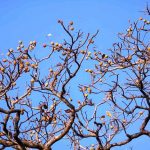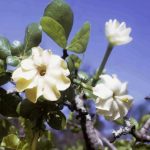TREE LIFE
July 1986
MASHONALAND CALENDAR
Saturday July 5th : Botanic Garden Walk. Meet at the Car Park at 1045 or 1100 hours.
Sunday July 20th : Darwendale Dam. An interesting venue which the Society visited many years ago. During the morning we will examine the riverine vegetation downstream from the dam wall, starting at the road bridge. The afternoon will be spent near the picnic site. The bus will leave Monomatapa Car Park at 0900 hours. The fare, which includes the security guard is $10.50.
MATABELELAND CALENDAR
Sunday July 6th : The Matopos. We go to Steadfast Park, Boys Brigade, near Sandy Spruit, on the Fort Usher Road. Meet at Retreat at 0830. Bring Lunch.
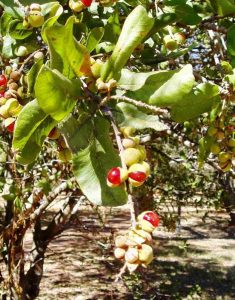
Pappea capensis. Photo: Mark Hyde. Source: Flora of Zimbabwe
On Sunday June 1st we went to Hillside Dams, where our renowned guides, the Archers, had located a new and interesting route, to the West of the Aloe Garden. This sounded a bit like the North Face of the Eiger. Indeed, it was quite a climb, however, we all made it, with much pleasure. In a couple of hours we identified some 50 trees, a contrast with our last outing on Kalahari Sand, where species are always relatively few. We saw three Acacia species, A.nilotica and A.rehmanniana but with A.galpinii predominating; some Aloes were flowering but not Aloe excela; Bridelia mollis, Canthium lactescens flowering late with a new lease on life after the unusual April rains; Cassine transvaalensis; Celtis africana was present everywhere, sometimes looking like a Grewia; Clerodendron glabrum and myricoides; the latter with its fine blue flower; Combretum molle, Commiphora mollis mostly with very square stems; C.schimperi what we thought was Cordia ovalis; Croton gratissimus; Cussonia natalensis; Dovyalis caffra and D.zeyheri; Ehretia rigida, Flacourtia indica was characteristically rather varied; Ficus glumosa, Ficus ingens and Ficus thonningii; Grewia flavescens and G.monticola; Kirkia acuminata; Maytenus heterophylla; Mimusops zeyheri Pappea capensis; Pavetta gardeniifolia; Pterolobium stellatum; Rhus leptodictya; Schrebera alata where one fine tree had died during the drought; Scolopia zeyheri which is a rarity here; Tetradenia brevispicata; Ximenia caffra and Ziziphus mucronata.
-C.Sykes
BOTANIC GARDEN WALK, 7TH JUNE 1986 : STRAIGHT THORN ACACIA SPECIES
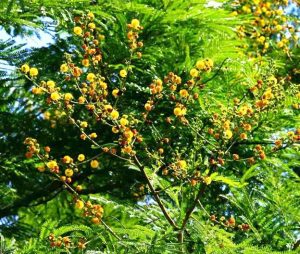
Acacia amythethophylla. Photo: Bart Wursten. Source: Flora of Zimbabwe
Having previously looked at Acacia species with hooked thorns, this month we turned our attention to those with straight thons, starting off with Acacia amythethophylla, a species easily recognize by its large leaves. The thorns which are really modified stipules, are not very conspicuous and the flowers are yellow and spherical and are very often galled. It occurs in woodland at medium altitudes. In Harare, it is common in Marlborough and Mabelreign and is frequent along the road to Shamva.
The next three species we looked at are those which have the narrowest leaves. Firstly we saw A.abyssinica with a leaf many times longer than broad. It has many pinnae and leaflets. The bark on the young shoots is flaky and in young trees is strikingly flaky on the trunk. We looked at two trees; one grown from seed collected in Kenya and this specimen was spectacularly flat topped, the other, which was grown from seed from the Eastern Districts, was also flat topped but much taller. This is the only tree Acacia from the high rainfall areas. It is very common in the eastern Districts, its southern most distribution area being the Chimanimanis.
Secondly, we looked at A.rehmanniana which has a tendency to have slightly longer leaves, slightly fewer pinnae and more leaflets but this is not a hard and fast rule. The best way to differentiate it is by its rusty red branches with a dense, grey, velvety indumentums. It could be confused with A.karroo which sometimes has rusty red branches but does not have the grey indumentums. It is found in the drier areas of the Midlands and in the west and, in Harare, can be seen growing along the Mukuvisi River.
Thirdly, we were shown A.arenaria which has longer leaves than the other two and fewer pinnae and leaflets giving the leaf a much more la appearance. Its branches grow in a zig zag fashion and it has very thin pods but it is most easily distinguished by its bushy habit and the fact that it occurs in the west of the country.
A.gerrardii does not have as many pinnae and leaflets as the above species. It bears long, straight thorns as well as smaller hooked ones and has a hairy indumentums and a very characteristic reddish under bark which is visible in dots and streaks at the ends of the branches.
A.nilotica is a very variable species which in the absence of pods could be confused with A.gerrardii or A.karroo. It does not, however, have the rusty red under bark typical of these species. If there is a pod on the tree or in the vicinity your problems are over as the pods are very distinctive being constricted between each seed. The bark, almost like Terminalia bark, has very typical longitudinal fissures which join and rejoin. There was some discussion as to what this is called but no conclusion was reached. This is a very wide spread species and is art of the thornveld in the west. It is very common in the lowveld and is seen at medium elevations but is not common on the Highveld.
A.karroo has leaves which are similar to A.nilotica but the leaflets are fewer and bigger. The tree has the general impression of A.rehmanniana but o close inspection there is no doubt as to its identity because the leaves are lax and broad. Both A.karroo and A.gerrardii have sickle shaped pods but A.karroo does not have the dots and streaks of reddish under bark visible on the new growth of A.gerrardii. It is a quick growing tree, common around Harare and grows in a wide variety of habitats, often along rivers. There are many different ecotypes of this species, the one from the Cape won’t grow here but the one from Zululand will just survive, this particular ecotype has none of the rustiness of our ecotypes.
A.robusta subsp. robusta has leaves which are very similar to those of A.karroo but it has fissured bark which A.karroo does not have. It is early flowering with cream coloured spherical flowers and is very typical of Matabeleland but has been recorded for Gona re Zhou.
A.robusta subsp. calvigera has the same type of leaf but a smooth grayish bark. The pods are sickle shaped. It is found o the deep soils of low altitude riverine habitats and also reaching into the mopane and the jesse. In the Zambezi Valley it occurs on alluvial soils with A.nigrescens, A.tortilis and a Combretum under storey.
A.grandicornuta also has leaves falling into this category and is distinguished by its thorns which reach 9cm in length. It is found along the border road from Vila Salazar down to the Limpopo.
Our thanks to Mr. Muller for a most informative walk.
-Barbara Browning
IVORDALE FARM – SUNDAY 15TH JUNE 1986
It was a lovely sunny day for our outing to Ivordale Farm, cool in the shade but warm in the sun. After a happy, relaxed drive out of Harare along the Enterprise Road we found our turnoff and bumped along the farm road to our destination.
After a short comfort stop Trevor Cox directed our fairly large party to some nearby kopjes for the morning walk. We split up into groups and I joined one led by Meg, who lost no time in heading out across the dry veld to the foot of the nearest kopje, passing through clumps of waist high Eriosema engleranum bearing amber-yellow flowers.
On tackling this write up and being surrounded by the creased and tattered remains of my mementoes of the trip I am resolved in future to carry a small note book which will hold specimens opposite which names and a few notes can be written. I had also better make it clear that this is not meant to be an account of our walk, only a memory jogger of some of the things we saw.
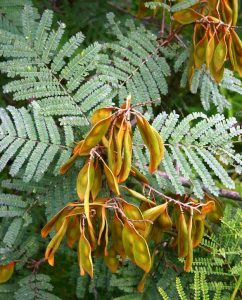
Peltophorum africanum. Photo: Bart Wursten. Source: Flora of Zimbabwe
The first item I want to note is Ziziphus mucronata, buffalo thorn, cousin to the lowveld Z.mauritiana that I was shown about a week ago sprouting up around the base of a lamp post in Baker Avenue opposite the House of Assembly. I learned then that its berries are used to make Kachasu and, incidentally, I don’t have the recipe. We moved on to an old favourite, a Peltophorum africanum, now heavy with the pods that follow the beautiful scented yellow flowers. Here I found out something new, it has stipules in the axils of the petioles which seen through a lens, are very clearly fern like.
Our first encounter with Croton gratissimus led to the call for a ‘hands on’ experience. This was to become a familiar cry during the morning and led to a deeper involvement as we passed along samples to be crushed, sniffed, and examined at close quarters. The leaves bear two glands at the base and when crushed exude a strong smell of lavender. The leaves are striking in appearance with silvery under surface. All bore the budded spikes of flowers which last for months before they open.
We were lucky to see two Grewia species growing close together, G.decemovulata with round stems which branch from ground level, the leaves being green on both sides have coarsely serrate margins; and G.flavescens which has abrasive asymmetric based leaves whose margins appear irregularly serrated and are green on the undersurface. Later in the day we found G.monticola, the leaves of which are harsh on the upper surface but pale and smooth below the margins being coarsely and irregularly toothed.
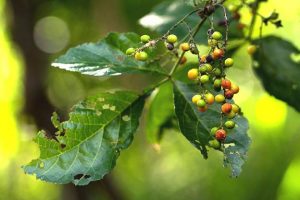
Allophyllus africanus. Photo: Bart Wursten. Source: Flora of Zimbabwe
Piliostigma thonningii, Bauhinia thonningii, monkey bread, was another item we often see on our outings and which has distinctive tin lobed leaves and large heavy pods at this time of the year. Conscious also of how often we come across leaves which are trifoliolate I mention a few found on the granite slopes; Rhoicissus tridentata whose leaves are serrated and which was laden with fruit. It was growing very close to Rhoicissus revoilii, with smooth margins. Both bearing similar growth patterns to the grape, the family in which they belong. Rhus leptodictya with lanceolate leaflets was another, together with Allophyllus africanus, an oft occurring favourite we have come to know as ‘hairy armpits’ which are really hairy when seen under the lens.
More ’hands on’ experience applied to Heteropyxis dehnias and this also revealed a lavender smell when the leaves were crushed. The bumps in the axils of the veins of the attractive shiny green leaves, were exciting, these could easily be seen without the aid of a lens. Another old friend was Maytenus undata with blue/green leaves bearing a whitish bloom which, when rubbed, reminded us of musty pantry shelves.
By now we had seen Sterculia quinueloba a number of times. Its satiny pink peeling bark and fruit suspended in start shaped formation from the ends of the branches had become a familiar sight but the leaves were missing, they were now brown and brittle either hanging suspended in trees nearby or lying on the ground, dry and crackly waiting for us to crunch them underfoot.
We saw six types of fig during the day, Ficus sycamorus with pale, yellowish trunk and rough leaves; F.glumosa, very exciting to see with its roots literally spilling over the top and down the sides of one particular rock face; F.natalensis with truncate leaves, midrib terminating before the blunt ends; a hug F.ingens, literally leaning over on an elbow, red tipped leaves shining in the sun; F.thonningii, woodland strangler with sessile figs, and lastly a huge G.salicifolia high up in the granite kopje behind the house, the ovate leathery leaves that survived the crushing in my bag are a strong reminder as I type my notes.
Those of us who scrambled to the top of the kopje behind the house to have lunch were well rewarded with a beautiful view to add to their refreshment and the return journey revealed a large hammerkop’s nest, not noticed on the way up.
The visit was most enjoyable and we thank our host, Trevor Cox, very much indeed and hope he enjoyed it as much as we did.
-Marjorie Barker
Other notable finds at Ivordale were two Commiphora species – C.mollis now leafless but with toffee like bark, and C.mossambicensis. The latter was also leafless but was hung with the green fruit that releases a characteristic pepper scented myrrh when crushed. This is also smelt when the bark is scratched, or the leaves crushed.
Despite my confidence in identifying Ficus ingens at Mazowe last month, the trees at Ivordale were more confusing. Many individual leaves had an identical venation to those on F.cordata subsp. salicifolia. This latter specimen, seen in the afternoon, did show the remarkably Salix like hanging leaves. The afternoon walk also revealed a row of grinding holes on a large granite boulder, the edge of each hemispherical cavity was a well defined circle.
Sadly this is where these notes come to an end and I am not able to find the missing pages – this is 30 years later – sorry about that. Mary Lovemore
KIM DAMSTRA CHAIRMAN


